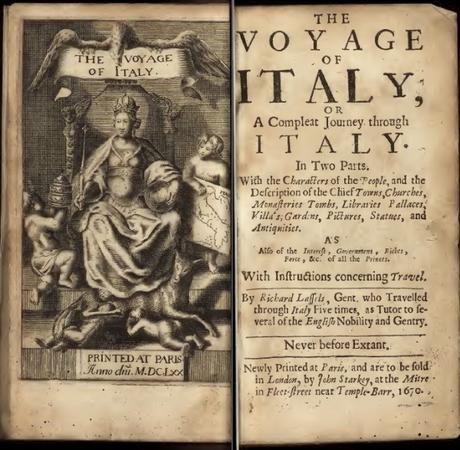Lucca in letteratura VIII
Creato il 20 luglio 2015 da Marvigar4

Richard Lassels (c. 1603–1668) fu un sacerdote cattolico inglese passato alla storia per i suoi viaggi in Italia e per aver inventato il cosiddetto Grand Tour, il viaggio obbligato per i giovani nobili inglesi e non solo attraverso l’Europa. Lassels, come tutor di molti giovani rampolli, ebbe modo di comunicare e trasmettere informazioni sulla civiltà italiana, nel 1670 uscì postumo a Parigi il suo Voyage or a Complete Journey through Italy, ma già nel 1654, in seguito al suo secondo viaggio in Italia, aveva scritto Description of Italy, il cui manoscritto originale è attualmente conservato presso la National Library of Scotland Advocates e pubblicato solo nel 1985. Qui di seguito si riporta la parte dedicata a Lucca del Voyage, molto interessante per scoprire com’era la città e la società lucchese nella seconda parte del XVII secolo. Degno di nota il fatto che Lassels citi Sante Pagnini, monaco domenicano nato a Lucca nel 1470, grande erudito e autore, dopo Girolamo, della traduzione della Bibbia dall’ebraico e dal greco.
Lucca is a pretty little Commonwealth, and yet it sleeps quietly within the Bosome of the Great Dukes State. But that State may wisely fear none, which no State fears; and the Great Duke is unwilling to measure his sword , or take up the Cudgels against little Lucca, least the World should cry shame upon him, and bid him meddle with his Match. This little Republick looked in my eye, like a perfect Map of old Rome in its beginning.
Its governed by a Confaloniero and the Gentry. The great Counsel consists of 160 Citizens who are changed every year. Its under the Emperors Protection; and is hath about thirty thousand souls in it. Approaching into it, it looked like a pure Low-Country Town, with its Bricks Walls, large Ramparts set round with Trees and deep Moats round about the Walls. It hath eleven Bastions well guarded by the Townsmen, and well furnished with Cannons of a large size. The Town is three miles in compass; it hath thirty thousand Muskets, or half Muskets in its Arsenal, eight thousand Pikes, two thousand Brest Pieces of Musket proof, and store of great Artillery. The whole State, for a need, can arm eighteen thousand men of service, and it hath about five hundred thousand French Livres a year. It was in this Town that Caesar, Pompey, and Crassus met; and agreed among themselves that all things in Rome should pass as they pleased.
The chief things to be seen here, are the Cathedral, called S. Martins, whose Bishop hath the Ensigns of an Archbishop, to wit, the use of the Pallium and the Cross, and whose Canons in the Quite wear a Rocchet and Camail, and Miters of silk like Bishops.
2. The Town-House, or Senate House, where the Confalionero lives during the time of his Charge.
3. The Church of S. Frediano belonging to the Canon Regulars, where, in a Chappel on the left hand , is the Tomb of S. Richard King of England who died here in his Pilgrimage to Rome.
4. The Augustins Church, where is seen a hole where the Earth opened to swallow up a blaspheming Gamester.
Of this Town was Pope Lucius the III. the two famous men of this Town, the one for Soldiery, the other for Learning, were, brave Castruccio, and Sanctus Pagninus a great Hebrician.
Richard Lassels, The Voyage of Italy, 1670
°°°°°°°°°°°°°°°°°°°°°°°°°°°°°°°°°°°°
Lucca è una piccosa graziosa repubblica, ciò nonostante riposa tranquillamente in seno allo Stato del Granduca. Ma quello Stato (Lucca) può saggiamente non temere nessuno che non lo tema; e il Granduca non è disposto a misurare la sua spada, o prendere le difese contro la piccola Lucca, altrimenti il mondo gli griderebbe addosso vergogna e lo inviterebbe a mischiarsi con un suo pari. Questa piccola Repubblica apparve ai miei occhi come una mappa perfetta dell’antica Roma ai suoi esordi.
È governata da un Gonfaloniere e dalla piccola nobiltà. Il gran Consiglio è composto da 160 cittadini che si alternano ogni anno. È sotto la protezione dell’Imperatore vi dimorano e circa trentamila anime. Avvicinandosi somiglia a una perfetta città dei Paesi Bassi, con le sue Mura in mattoni, grandi bastioni che la circondano con alberi e profondi fossati intorno alle Mura. Ha undici baluardi ben custoditi dai cittadini, e ben equipaggiati di cannoni di grandi dimensioni. La circonferenza della città è di tre miglia; possiede trentamila moschetti, o moschetti e mezzo nel suo arsenale, ottomila picche, duemila corazze a prova di moschetto, e un deposito di grande artiglieria. L’intero stato, per necessità, può chiamare alle armi diciottomila uomini, e ha un bilancio di cinquecentomila lire francesi all’anno. Fu in questa città che Cesare, Pompeo e Crasso si incontrarono e si accordarono perché tutto a Roma accadesse secondo il loro piacimento.
Le cose principali da vedere qui sono la Cattedrale, chiamata S. Martino, il cui Vescovo ha le insegne di un Arcivescovo, ossia, l’uso del Pallio e della Croce, e i cui canonici nella cappella indossano un rocchetto e una mozzetta, e mitra di seta come i vescovi.
2. Il municipio, o Senato, dove il Gonfaioniere vive durante il periodo della sua carica.
3. La Chiesa di S. Frediano che appartiene ai canonici regolari, dove, in una cappella sulla navata sinistra, si trova la Tomba di S. Riccardo Re di Inghilterra [1], che qui morì durante il suo pellegrinaggio a Roma.
4. La Chiesa di Agostino, in cui si vede un buco dove la terra si aprì per inghiottire un baro bestemmiatore.
Di questa città fu Papa Lucio III. I due uomini famosi di questa città, uno per valore militare, l’altro per la cultura, furono il coraggioso Castruccio e Sante Pagnini [2], un grande ebraista.
Potrebbero interessarti anche :

